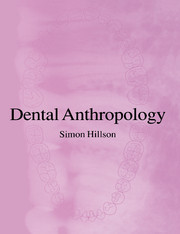Book contents
- Frontmatter
- Contents
- Acknowledgements
- Abbreviations
- 1 Introduction to dental anthropology
- 2 Dental anatomy
- 3 Variation in size and shape of teeth
- 4 Occlusion
- 5 Sequence and timing of dental growth
- 6 Dental enamel
- 7 Dentine
- 8 Dental cement
- 9 Histological methods of age determination
- 10 Biochemistry of dental tissues
- 11 Tooth wear and modification
- 12 Dental disease
- 13 Conclusion: current state, challenges and future developments in dental anthropology
- Appendix A: Field and laboratory methods
- Appendix B: Microscopy
- References
- Index
9 - Histological methods of age determination
Published online by Cambridge University Press: 05 June 2012
- Frontmatter
- Contents
- Acknowledgements
- Abbreviations
- 1 Introduction to dental anthropology
- 2 Dental anatomy
- 3 Variation in size and shape of teeth
- 4 Occlusion
- 5 Sequence and timing of dental growth
- 6 Dental enamel
- 7 Dentine
- 8 Dental cement
- 9 Histological methods of age determination
- 10 Biochemistry of dental tissues
- 11 Tooth wear and modification
- 12 Dental disease
- 13 Conclusion: current state, challenges and future developments in dental anthropology
- Appendix A: Field and laboratory methods
- Appendix B: Microscopy
- References
- Index
Summary
Alternative ageing methods – how accurate is accurate?
Dental histology provides a variety of methods for estimating age at death in adult remains, but they compete with techniques based upon the macroscopic examination of skeleton and dentition. The most commonly used methods are based upon changes to the bony parts of joints in the pelvis (the pubic symphysis and the auricular area), and dental attrition (page 239). Other methods include changes to the sternal end of the fourth rib, and cranial sutures. The closeness of the relationship between estimated ages and known ages is usually expressed by a correlation coefficient, the mean difference between estimated age and known age, or a standard error of estimate. Table 9.1 shows that no adult ageing method is highly accurate and, to be as good as the competition, dental histological methods need only have correlation coefficients of 0.7, or average differences between estimated and known age of less than 7 years. Several of the dental histological techniques emerge as relatively good methods and their limited application outside forensic odontology is probably due to the degree of training required, and the time-consuming, destructive sectioning.
Counts of layers in cement
In marine mammals, hibernating land mammals, migratory ungulates and their dependent carnivores, cement layering is routinely used as an ageing method (Morris, 1978; Perrin & Myrick, 1980; Hillson, 1986a, 1992; Lieberman, 1993).
- Type
- Chapter
- Information
- Dental Anthropology , pp. 207 - 216Publisher: Cambridge University PressPrint publication year: 1996



